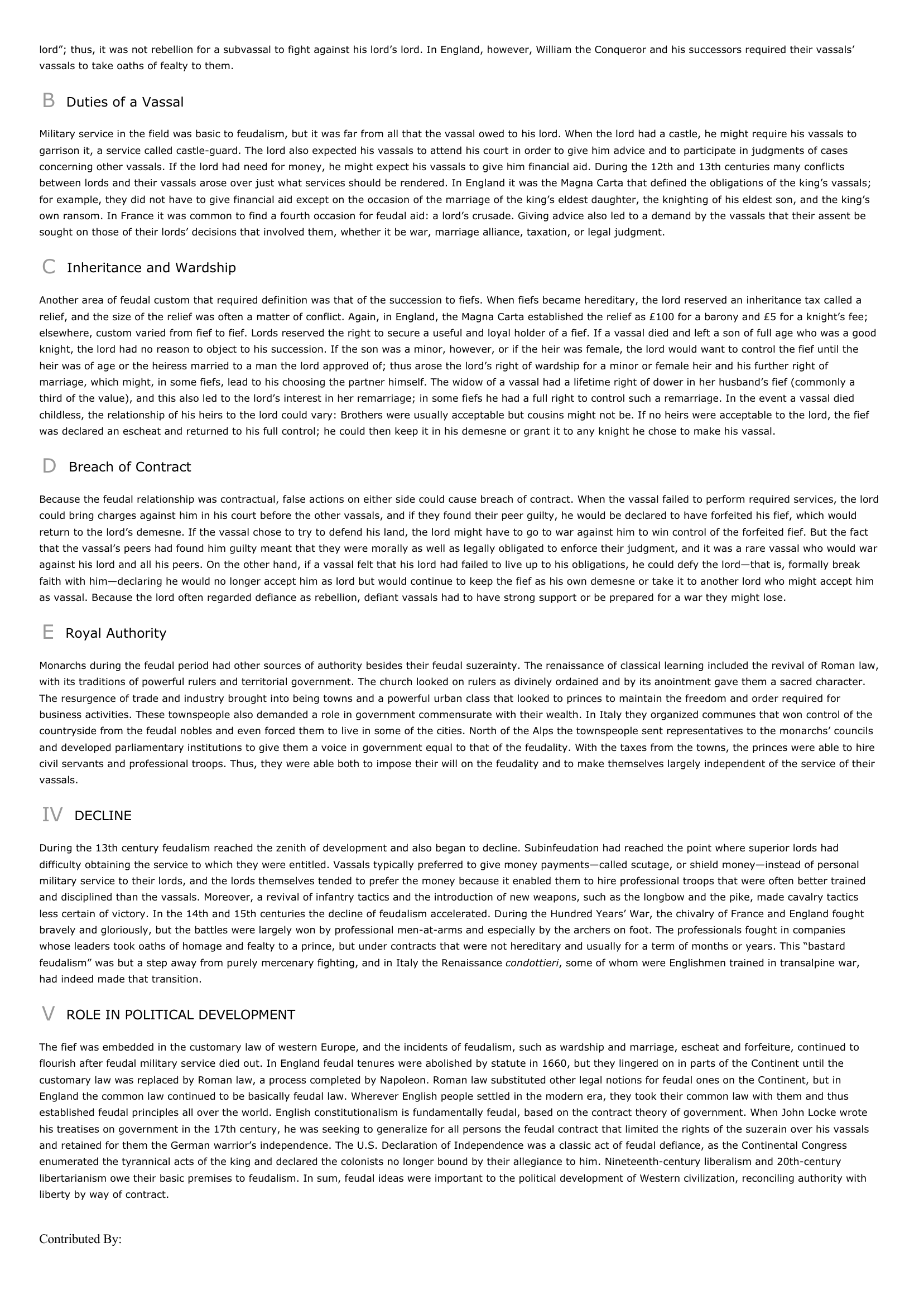Feudalism I INTRODUCTION Feudalism, contractual system of political and military relationships existing among members of the nobility in Western Europe during the High Middle Ages.
Publié le 03/05/2013

Extrait du document


«
lord”; thus, it was not rebellion for a subvassal to fight against his lord’s lord.
In England, however, William the Conqueror and his successors required their vassals’vassals to take oaths of fealty to them.
B Duties of a Vassal
Military service in the field was basic to feudalism, but it was far from all that the vassal owed to his lord.
When the lord had a castle, he might require his vassals togarrison it, a service called castle-guard.
The lord also expected his vassals to attend his court in order to give him advice and to participate in judgments of casesconcerning other vassals.
If the lord had need for money, he might expect his vassals to give him financial aid.
During the 12th and 13th centuries many conflictsbetween lords and their vassals arose over just what services should be rendered.
In England it was the Magna Carta that defined the obligations of the king’s vassals;for example, they did not have to give financial aid except on the occasion of the marriage of the king’s eldest daughter, the knighting of his eldest son, and the king’sown ransom.
In France it was common to find a fourth occasion for feudal aid: a lord’s crusade.
Giving advice also led to a demand by the vassals that their assent besought on those of their lords’ decisions that involved them, whether it be war, marriage alliance, taxation, or legal judgment.
C Inheritance and Wardship
Another area of feudal custom that required definition was that of the succession to fiefs.
When fiefs became hereditary, the lord reserved an inheritance tax called arelief, and the size of the relief was often a matter of conflict.
Again, in England, the Magna Carta established the relief as £100 for a barony and £5 for a knight’s fee;elsewhere, custom varied from fief to fief.
Lords reserved the right to secure a useful and loyal holder of a fief.
If a vassal died and left a son of full age who was a goodknight, the lord had no reason to object to his succession.
If the son was a minor, however, or if the heir was female, the lord would want to control the fief until theheir was of age or the heiress married to a man the lord approved of; thus arose the lord’s right of wardship for a minor or female heir and his further right ofmarriage, which might, in some fiefs, lead to his choosing the partner himself.
The widow of a vassal had a lifetime right of dower in her husband’s fief (commonly athird of the value), and this also led to the lord’s interest in her remarriage; in some fiefs he had a full right to control such a remarriage.
In the event a vassal diedchildless, the relationship of his heirs to the lord could vary: Brothers were usually acceptable but cousins might not be.
If no heirs were acceptable to the lord, the fiefwas declared an escheat and returned to his full control; he could then keep it in his demesne or grant it to any knight he chose to make his vassal.
D Breach of Contract
Because the feudal relationship was contractual, false actions on either side could cause breach of contract.
When the vassal failed to perform required services, the lordcould bring charges against him in his court before the other vassals, and if they found their peer guilty, he would be declared to have forfeited his fief, which wouldreturn to the lord’s demesne.
If the vassal chose to try to defend his land, the lord might have to go to war against him to win control of the forfeited fief.
But the factthat the vassal’s peers had found him guilty meant that they were morally as well as legally obligated to enforce their judgment, and it was a rare vassal who would waragainst his lord and all his peers.
On the other hand, if a vassal felt that his lord had failed to live up to his obligations, he could defy the lord—that is, formally breakfaith with him—declaring he would no longer accept him as lord but would continue to keep the fief as his own demesne or take it to another lord who might accept himas vassal.
Because the lord often regarded defiance as rebellion, defiant vassals had to have strong support or be prepared for a war they might lose.
E Royal Authority
Monarchs during the feudal period had other sources of authority besides their feudal suzerainty.
The renaissance of classical learning included the revival of Roman law,with its traditions of powerful rulers and territorial government.
The church looked on rulers as divinely ordained and by its anointment gave them a sacred character.The resurgence of trade and industry brought into being towns and a powerful urban class that looked to princes to maintain the freedom and order required forbusiness activities.
These townspeople also demanded a role in government commensurate with their wealth.
In Italy they organized communes that won control of thecountryside from the feudal nobles and even forced them to live in some of the cities.
North of the Alps the townspeople sent representatives to the monarchs’ councilsand developed parliamentary institutions to give them a voice in government equal to that of the feudality.
With the taxes from the towns, the princes were able to hirecivil servants and professional troops.
Thus, they were able both to impose their will on the feudality and to make themselves largely independent of the service of theirvassals.
IV DECLINE
During the 13th century feudalism reached the zenith of development and also began to decline.
Subinfeudation had reached the point where superior lords haddifficulty obtaining the service to which they were entitled.
Vassals typically preferred to give money payments—called scutage, or shield money—instead of personalmilitary service to their lords, and the lords themselves tended to prefer the money because it enabled them to hire professional troops that were often better trainedand disciplined than the vassals.
Moreover, a revival of infantry tactics and the introduction of new weapons, such as the longbow and the pike, made cavalry tacticsless certain of victory.
In the 14th and 15th centuries the decline of feudalism accelerated.
During the Hundred Years’ War, the chivalry of France and England foughtbravely and gloriously, but the battles were largely won by professional men-at-arms and especially by the archers on foot.
The professionals fought in companieswhose leaders took oaths of homage and fealty to a prince, but under contracts that were not hereditary and usually for a term of months or years.
This “bastardfeudalism” was but a step away from purely mercenary fighting, and in Italy the Renaissance condottieri , some of whom were Englishmen trained in transalpine war, had indeed made that transition.
V ROLE IN POLITICAL DEVELOPMENT
The fief was embedded in the customary law of western Europe, and the incidents of feudalism, such as wardship and marriage, escheat and forfeiture, continued toflourish after feudal military service died out.
In England feudal tenures were abolished by statute in 1660, but they lingered on in parts of the Continent until thecustomary law was replaced by Roman law, a process completed by Napoleon.
Roman law substituted other legal notions for feudal ones on the Continent, but inEngland the common law continued to be basically feudal law.
Wherever English people settled in the modern era, they took their common law with them and thusestablished feudal principles all over the world.
English constitutionalism is fundamentally feudal, based on the contract theory of government.
When John Locke wrotehis treatises on government in the 17th century, he was seeking to generalize for all persons the feudal contract that limited the rights of the suzerain over his vassalsand retained for them the German warrior’s independence.
The U.S.
Declaration of Independence was a classic act of feudal defiance, as the Continental Congressenumerated the tyrannical acts of the king and declared the colonists no longer bound by their allegiance to him.
Nineteenth-century liberalism and 20th-centurylibertarianism owe their basic premises to feudalism.
In sum, feudal ideas were important to the political development of Western civilization, reconciling authority withliberty by way of contract.
Contributed By:.
»
↓↓↓ APERÇU DU DOCUMENT ↓↓↓
Liens utiles
- African Music I INTRODUCTION Sacred Christian Music of Nigeria Among the Igede people of Nigeria, Christianity has been syncretized with the existing religious belief system.
- Adolf Hitler I INTRODUCTION Adolf Hitler (1889-1945), German political and military leader and one of the 20th century's most powerful dictators.
- Karl Marx I INTRODUCTION Karl Marx (1818-1883), German political philosopher and revolutionary, the most important of all socialist thinkers and the creator of a system of thought called Marxism.
- Holy Roman Empire I INTRODUCTION Holy Roman Empire, political entity of lands in western and central Europe, founded by Charlemagne in AD 800 and dissolved by Emperor Francis II in 1806.
- Holocaust I INTRODUCTION Holocaust, the almost complete destruction of Jews in Europe by Nazi Germany and its collaborators during World War II (1939-1945).


















